Everything About Langtang Valley Trek For Beginners To Experienced Trekkers In 2025
On the Langtang Valley Trek, you’ll get a close-up view of seven massive peaks above 6000m.
However, that’s not the only reason you should be going on this trek. There are numerous other reasons, which we will discuss in a while.
But, before that, we need to first understand a little about this trek.
Located just north of Kathmandu, inside Langtang National Park, this trek is a combination of majestic views, rare flora and fauna, and a unique cultural experience.
This trek usually starts from Syabrubesi (2,380m or 7,808 ft). By the end of the trek, you will reach Kyanjin Gompa (3,870 m or 12,697 ft).
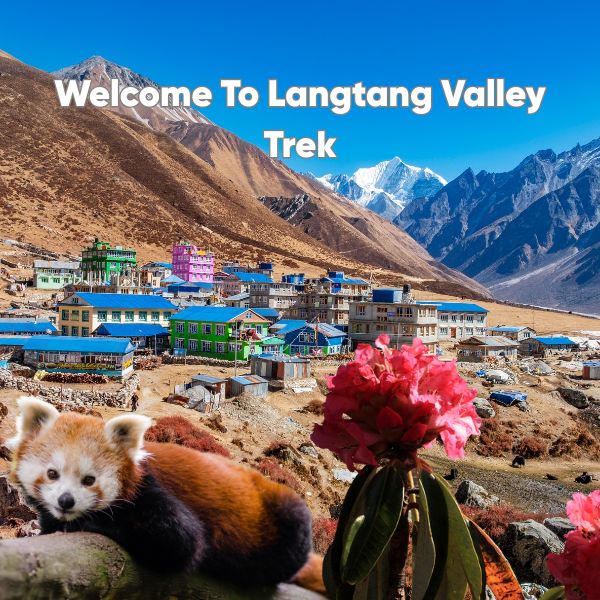
However, if you are an experienced trekker, you can reach up to Kyanjin Ri.
While doing back and forth, you can expect to cover around 70 to 80 kilometers or 43 to 50 miles. If you are a beginner, you can expect to finish the trek in 11 days. On the other hand, most experienced trekkers can easily
finish this trek in 5 to 6 days.
Now that you have understood a little about the trek, let us tell you why you should keep Langtang Valley Trek on your 2025 bucket list.
Why You Should Visit Langtang Valley Trek In 2025?
Yes, the trail itself being beautiful is enough reason for you to visit Langtang Valley Trek. However, there exist a few other reasons as well.
The reasons are listed below:
1. Supporting Local Economy
Do you remember the devastating 7.8 magnitude earthquake that hit Nepal on April 15, 2015?
This devastating phenomenon didn’t only take lives, it also destroyed the livelihood of many locals. And one of the places that suffered heavily was the Langtang Valley Trek.
For many decades, tourism was the major source of income in this region. But, due to the earthquake, most of the trekking routes faced heavy damage. In fact, some of the trails were completely destroyed.
You can read this article by NASA to know what exact damages Langtang Trek faced.
Since then, the economy of this region has taken a major hit.
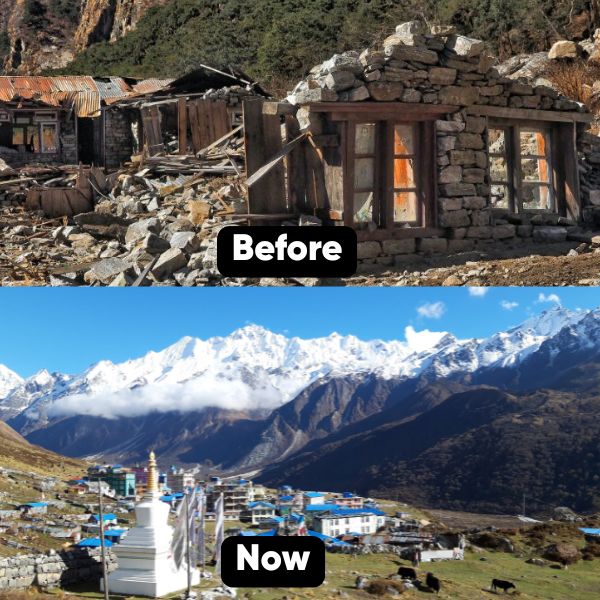
Now, when you visit this trek, you will be instantly amazed at how they have been able to rebuild.
Furthermore, most of the accommodation centers like lodges and teahouses are actually owned by locals.
So, by visiting this trek you not only get heavenly views, but you will also be supporting the local economy.
2. Safer Accommodation Centers
After the earthquake, most accommodation centers in this region were rebuilt.
While rebuilding, the locals made sure the teahouses were safer than ever. With the help of the government, they shifted from traditional-style centers to earthquake-safe structures.

Since the earthquake, most of the centers have ticked a box on safety and hygiene.
Note: Most of the accommodation centers are basic. You can enjoy basic amenities, but you might have to share a toilet and a room at times.
3. Exploring Rare Flora And Fauna
Langtang Valley Trek in itself is a gateway to one of the 12 national parks of Nepal.
The guides, the locals, and the government have made significant efforts to save the nature of this region. In fact, the guides for this trek are actually trained to be compliant with environmental regulations.
Furthermore, while going through the trek you will be able to find more than 1500 species of flora and fauna combined. And each of them is rare, respected, and preserved by locals.
Talk about dedication!!!!
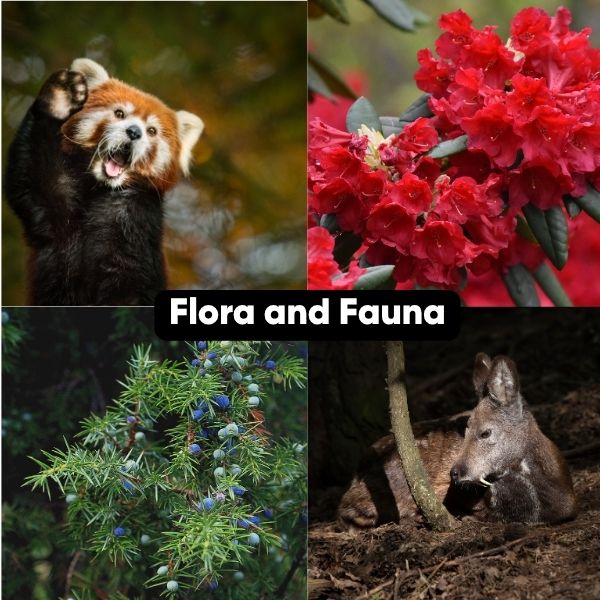
Besides these points, there is also a factor that no one really talks about.
This trek is absolutely friendly for beginners!!!!
Langtang Valley Trek Is Great For Both Beginners And Experts
One of the coolest part about this trek is, it is suitable for both beginners and experts
Langtang Valley Trek For Beginners
For newbie trekkers, Langtang is a place where they can find their footing.
First thing, it’s short. You don’t need weeks and weeks off from your life. You can complete the whole trek in just 7 to 10 days.
Second, it’s close to Kathmandu. A simple 6–7 hour drive and you are already on the trail. You don’t have to go through long travel plans or take flights.
Talking about the path itself, yes it has some climbs (it’s trekking). However, it’s not something that makes you want to quit the trek altogether.
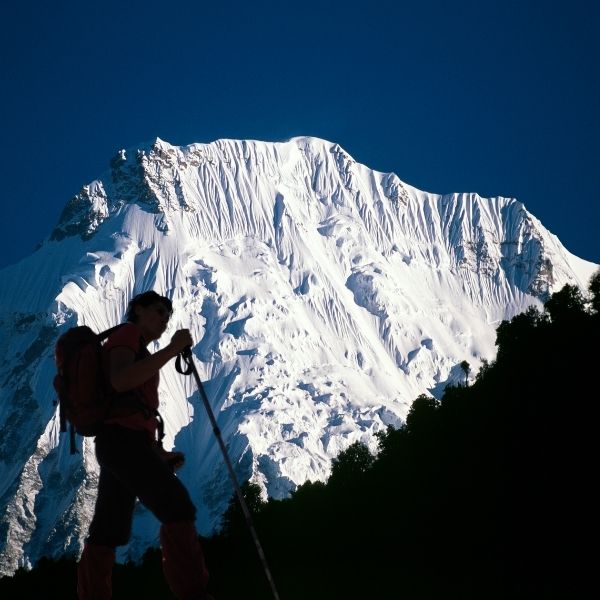
And if you don’t challenge yourself, the highest point is at Kyanjin Gompa. Its altitude is just 3,870m and most trekkers won’t get nasty altitude sickness at this altitude.
Additionally, even as a beginner, you still get those insane views of Langtang Lirung, Yala Peak, and Dorje Lakpa.
Besides that, you will walk through Tamang and Tibetan culture. During your trek, you will see unique food, prayers, mani walls, and if you’re lucky, a RED PANDA.
Langtang Valley Trek For Experts
But hey, don’t think this trek is only for newbies.
If you’re experienced, this place is your playground.
You can extend to Yala Peak or Gosainkunda Lake to challenge yourself. Furthermore, there are side trails like Kyanjin Ri and Tserko Ri that most trekkers never even see.
Note: For all the trekking genius out there we have developed package where you can see the full beauty of Gosaikunda Lake. It’s a 15 a day trek do check it out !!!
Besides that, the altitude gain here is quick, which is perfect to test how well you handle acclimatization. And since it’s a bit less crowded than Everest or Annapurna, you get that peace and raw wilderness vibe that expert trekkers love.
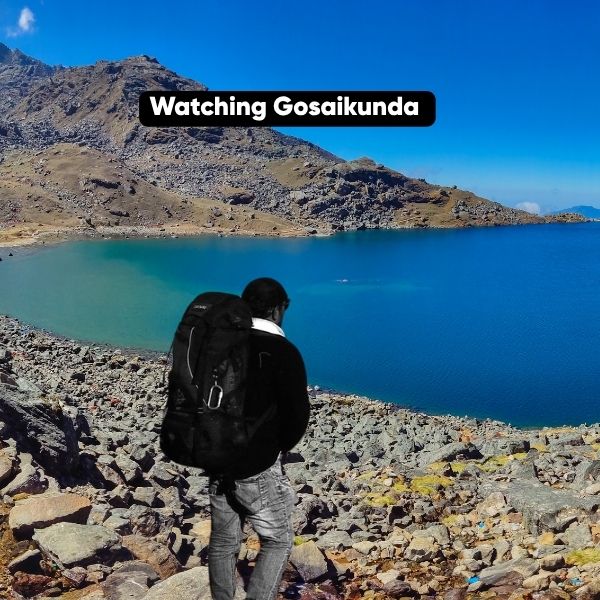
Additionally, it is one of those few treks where trekking is possible in any season. All you need to do is pack the right gear and you are good to go.
Some pros finish the trek in just 5–6 days. Others connect it with Helambu or Gosainkunda to make it one long, tough adventure.
Check out our package of 5 days that’s well suited for experienced trekker: Langtang Valley Trek 5 Days Itinerary And Cost In 2025
Well, the bottom line is, both beginners and experts get something when they trek in Langtang Valley.
Bonus point: If you have an interest in photography, you are in heaven. The combination of wildlife, glaciers, and alpine terrain gives you postcard-worthy photos at every step.
Best Itinerary For Langtang Valley Trek
Now, you know what you can expect from this trek. Let us suggest you the best itinerary that will keep you safe and increase your experience manifold.
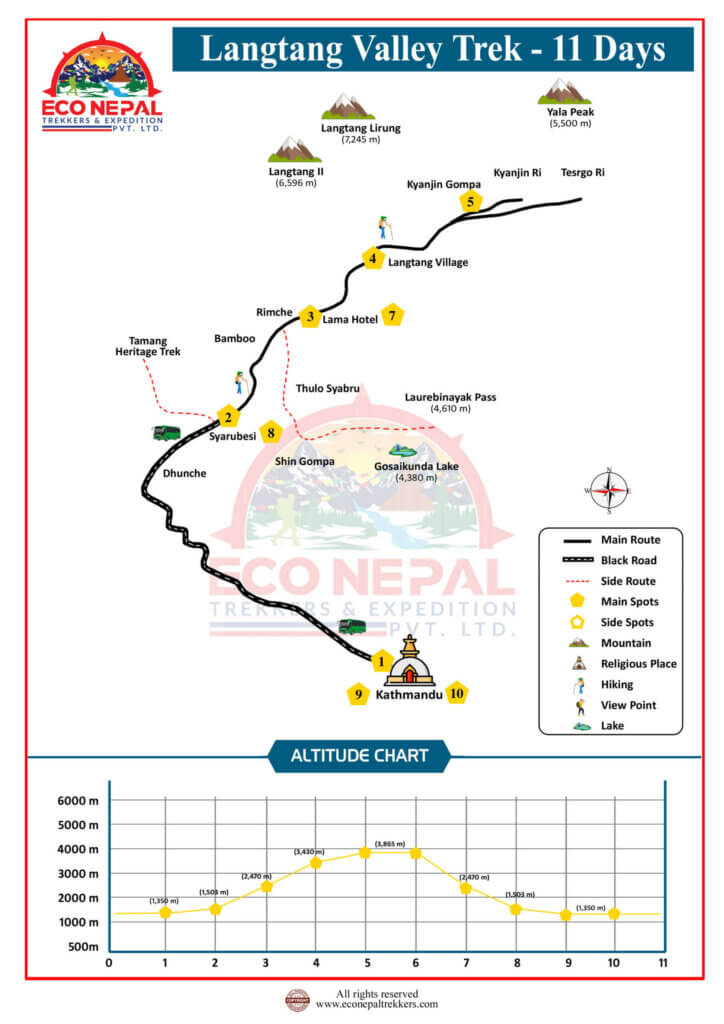
For 2025, we checked feedback from trekkers who actually walked these trails. Then we added a bit of common sense about altitude safety. So after considering all the factors, here is what we came up with:
Day 1: Kathmandu to Lama Hotel (2,350m)
Your journey kicks off with a drive from Kathmandu to Syabrubesi. It takes around 7–8 hours depending on road conditions (and yes, they can get bumpy).
After that, you do a short trek of around 4–5 km with about 700m of elevation gain to reach Lama Hotel.
Overall, expect 6–7 hours of travel and trekking combined. This is your first night in the mountains.
Day 2: Lama Hotel to Langtang Village (3,307m)
This day is when you start to feel you’re in the Himalayas. You climb about 950m in a 6 km stretch.
The trail takes you through beautiful forests and small settlements.
This is the day when you start to see snow-capped peaks like Langtang II, Ghangchenpo, Yala Peak, Naya Khang, and Ganesh Himal Range peeking through.
It takes around 5–6 hours for you to complete this trek.
Day 3: Langtang Village to Kyanjin Gompa (3,749m)
From Day 3, altitude starts to play a big role.
You gain about 450m and cover roughly 8 km in 5–6 hours. The terrain slowly changes from forest to open alpine meadows.
For all the cultural enthusiasts out there, yes, this is the day you start seeing true Himalayan culture.
Day 4: Acclimatization at Kyanjin
This is a rest day but trust us, it’s not boring. You can do optional short hikes (maybe up to Kyanjin Ri or check out nearby glaciers).
It’s basically a “climb high, sleep low” training day, which helps your body adjust to the thin air.
Day 5: Kyanjin to Tserko Ri (4,984m) and Back
Here’s your big climb day. You go up more than 1,200m, reaching 4,984m at the top of Tserko Ri.
Now don’t panic—you aren’t going to spend a night here.
You come back to sleep at Kyanjin’s safer 3,749m. It’s a 7–8 hour day.
But if you ask us, it is one of the best days as the insane 360-degree view just blows your mind.
Day 6: Kyanjin back to Lama Hotel (2,350m)
Time to descend and give your lungs some easy breathing.
You drop more than 1,400m as you trace back your steps. It takes about 6–7 hours.
Day 7: Lama Hotel to Kathmandu
A short 4 km trek back to Syabrubesi and then the long drive (6–8 hours) back to Kathmandu.
By evening, you’re back in the city craving pizza or dal bhat.
Why This Itinerary Works
The biggest reason why it works is because it provides Altitude safety.
Normally, almost 40–50% of trekkers at altitudes above 3,500m face some symptoms of altitude sickness. That’s a lot.
But having that acclimatization day at Kyanjin reduces this risk by around 30–40%.
Also, this itinerary follows the “less than 300m sleeping altitude gain rule” after Day 3.
On Day 5, even though you push to Tserko Ri (4,984m), you return to sleep low at Kyanjin (3,749m), which is how pros handle high altitude.
Alternate Acclimatization Options For Beginners
Now if you are a beginner, you can also try different acclimatization options. Here are some of the best options for beginners:
- Option A: Spend an extra night at Lama Hotel (2,350m) before heading up to Langtang Village. This gives your body more time to adjust.
- Option B: Spend an extra night at Langtang Village (3,307m) instead of rushing to Kyanjin. (Slower climb = happier lungs.)
- Option C: Do small side hikes on rest days like Kyanjin Ri (4,773m) but return to lower altitude to sleep.
These small changes in plans follow the medical guideline of climbing slow and low. Trust us, it will cut the risk of AMS almost in half.
And hey for those folks who is just trying to find their footing in trekking, we have developed 11 day package on Langtang Valley Trek. Do read it in detail.
Daily Distance And Time
On average, you’ll walk 10–15 km per day for 5–7 hours, except on the Tserko Ri climb day which stretches to 7–8 hours.
This keeps it accessible for beginners but still exciting for seasoned trekkers who might want to push harder.
Who Should Follow This Itinerary
- Beginners: It’s slow enough to keep you safe and comfortable.
- Experts: You can speed-run it in 5–6 days or extend it with Gosainkunda or Helambu.
Either way, the success rate on this itinerary is super high. 90% of trekkers complete it without major issues.
And with guides who actually understand acclimatization, your odds only get better.
Trekking Preparation Tips for Langtang Valley
Now, you might be wondering how one can prepare for this trip.
Let us tell you the harsh truth. Even though the trek itself is friendly, it’s still in the Himalayas. That means altitude, unpredictable weather, and long walking hours.
As a matter of fact, Langtang Valley Trek’s overall difficulty is rated as moderate, and Langtang’s preparation phase starts 4-5 weeks before the trek.
If you prepare well, your trek will be way more comfortable and your chances of completing it (without cursing your legs) will shoot up.
Physical Fitness Preparation Tips
You don’t need to be an athlete, but you do need some basic fitness.
Start at least 2–3 months before the trek. Go for hikes with a backpack, climb stairs, jog, or cycle. Basically, do anything that makes your lungs and legs stronger.
Why? Because above 3,000 m the oxygen levels drop. Even simple walking can feel like a workout.

Studies show people who did aerobic and strength training before trekking had 30–35% higher success rates.
Besides that, strength training is equally important.
Before planning for a trek, you can try exercises like squats, lunges, and planks. These exercises will make sure your legs and core can handle long walking days.
Just imagine how easy you will feel if you already have experience of doing 60-90 min walk carrying 10-12 kg bag.
Gear You Should Pack
Another thing you need to prepare for is what you need to pack. Bad gear is still one of the biggest mistakes trekkers around the world make.
Shoes:
Please, don’t show up in sneakers. Invest in proper trekking boots with ankle support. A good pair reduces ankle injuries by over 50%. Break them in before you come.
Sleeping Bag:
Even though you sleep in lodges, nights get freezing (especially above 3,000 m). Bring or rent a -10°C sleeping bag.
82% of trekkers last year used one, and trust us, they slept better.
Furthermore, we recommend you go for down bags as they are warmer and lighter. However, if you are worried about moisture, synthetic ones work as well.
Other Things To Pack:
- Trekking poles (your knees will thank you)
- Layered clothing (base, fleece, waterproof shell, and a down jacket)
- Gloves
- Hat
- Sunglasses
- Sunscreen
- Water purification tablets
- Headlamp
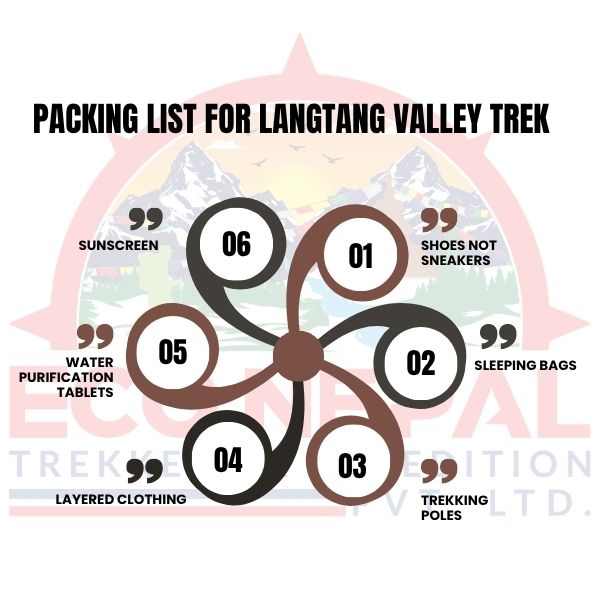
Now if you are worried about “How can I carry all these from my home?” No worries, both Kathmandu and Syabrubesi have many rental shops where you can find all these items.
And the cost? It’s just around a few hundred rupees per day.
Health & Safety
Altitude sickness (AMS) is real. Around 20–25% of Langtang trekkers experience mild symptoms like headache or nausea.
In rare cases (1–2%), people need to go down or even get evacuated. That’s why the acclimatization day at Kyanjin is non‑negotiable. It reduces your AMS risk by 30–40%.
Furthermore, you need to drink at least 3–4 liters of water daily and eat well.
And if you really want to be safe, see a doctor before the trek and discuss if you need medicines like Diamox (some trekkers use it, but slow climbing is still the best solution).
Talking about injuries, ankle sprains and knee pain are common on rocky trails, which is why we keep saying – WEAR PROPER SHOES and USE TREKKING POLES.
Besides that, we also recommend you get travel insurance. Even after all the preparation, nature can be tricky.
Here is quick recommendation of travels as per your country:
| Country | Name Of The Insurance Company |
|---|---|
| USA/Canada | World Nomads, IMG Global, Battleface, InsureMyTrip |
| UK/Europe | True Traveller, World Nomads, Battleface |
| Australia/New Zealand | World Nomads, Battleface |
| Other countries | World Nomads, Battleface, IMG Global |
And if needed, you need to opt for emergency rescues.
Quick fact: Around 0.3% of trekkers opt for emergency rescue in Langtang Valley Trek.
Why All This Matters
Now you might be thinking:
“It’s only a 7-day trek, why bother training or spending on gear?”
But the difference between someone who trained and packed right versus someone who didn’t is huge.
Trained trekkers don’t just finish easily; they enjoy the trek way more.
They take pictures, interact with locals, and actually enjoy the views instead of huffing and puffing with every step.
And the best part? When you prepare properly, your trek feels less like “survival” and more like a once-in-a-lifetime experience—which is what we all hope for!!
If you want to know in details for preparation to Langtang Valley Trek read our article: Langtang Valley Trek Preparation Guide
Accommodation And Its Costs In Langtang Valley Trek
Now, you are prepared and you know what your day will be like. But wait, there are still some things missing.
Oh yeah, you guys need to have an idea about the accommodation as well.
The good news is you don’t have to carry tents or sleep under the stars (unless you want to). In this part of the Himalayas, you will find tons of tea houses and lodges.
In our previous section, we already mentioned these tea houses are safe and provide you with the much-needed comfort. And now, we will be talking about the cost that you might be spending to spend a night in each of these places.
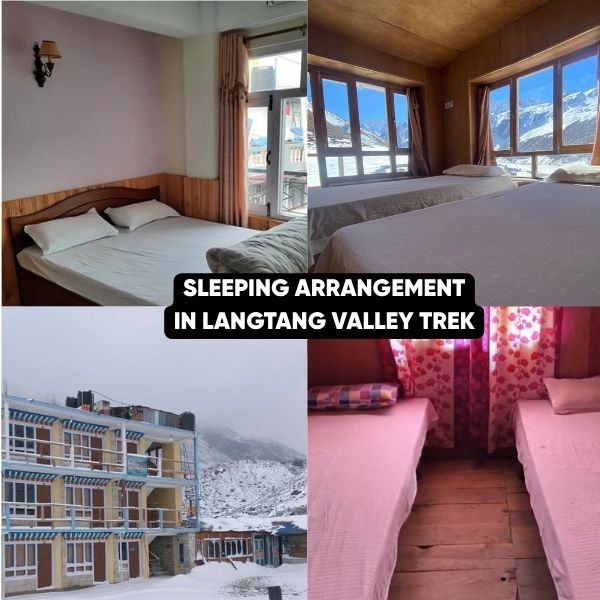
First, let’s start with Syabrubesi!! Here, accommodation standards are similar to what you get in Kathmandu. And the prices range from NPR 500–2,000 ($4–$15) depending on the comfort level. Once you start moving up, things get simpler but cozier.
Then in Lama Hotel, there are around 5–12 tea houses. The tea houses in this region have the capacity to host around 200–250 trekkers. Talking about rooms, they are basic, usually with two or three beds. Depending upon the comfort level you choose, the price can be anywhere from NPR 400–800 ($3–$6).
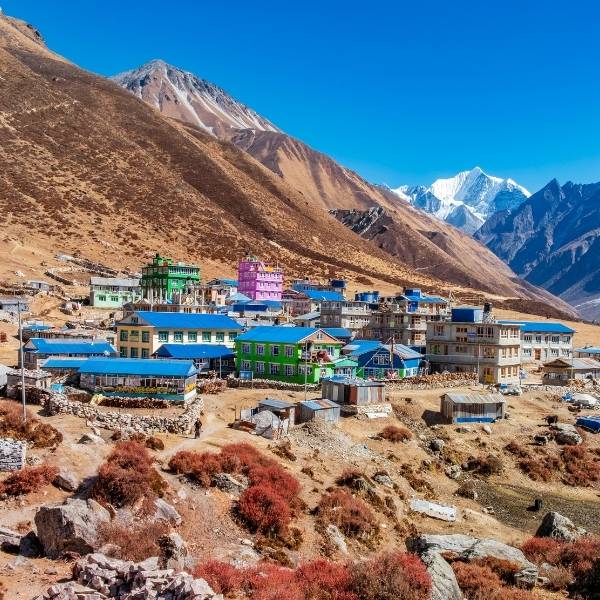
Now, let’s talk about the Langtang Village (the one that faced heavy damage in the 2015 earthquake). After the 2015 earthquake, most of the accommodation centers were rebuilt. This region now has around 16–18 lodges. These lodges can easily accommodate up to 500–700 trekkers. However, prices here are slightly high.
You might be spending around NPR 800–1,200 ($6–$10) for a night.
Now, let’s talk about the lodges in Kyanjin Gompa. Being one of the highest villages on this trek, it has 12–15 lodges with space for 700–1,000 trekkers. And, prices here are also on the higher side (altitude makes everything expensive).
But prices can fluctuate pretty quickly depending on the season.
During peak seasons (March–May and September–November), rooms can fill up quickly and rates go up to the higher end.
In off-seasons, not only is availability better, but you might even get a private room for the same cost as a shared one.
Here is the detail overview for every location:
| Location | Room Cost (Approx.) | Capacity | Notes |
|---|---|---|---|
| Syabrubesi | $4–15/night | Medium-high | Similar to Kathmandu standard |
| Lama Hotel | $3–6/night | 200–250 trekkers | Basic tea house style |
| Langtang Village | $6–10/night | 500–700 trekkers | More options, rebuilt lodges |
| Kyanjin Gompa | $6–13/night | 700–1,000 trekkers | Higher price due to altitude |
What Kind Of Food Will You Get During Langtang Valley Trek?
Food is one thing you will always remember on Himalayan treks, and Langtang is no different.
The most common meal out here is Dal Bhat (rice, lentils, veggies, and sometimes meat).
It costs $4–7 but comes with unlimited refills. You can get around 650 kcal energy and 18 g of protein per serving.
However, if you crave something else, you can opt for other meals as well.
Other popular items include:
- Momos (dumplings): $3–5
- Noodles, Fried Rice, Pasta, Pizza: $6–12
- Breakfast sets (porridge, eggs, toast, tea): NPR 800–1,500 ($5–11)
As you go higher, prices increase by about 20–30% because everything has to be carried up.
Bottled water, for example, costs $2–3/L at lower altitudes and up to $4–5/L higher up.
If you are budget-conscious, we recommend you go for Dal Bhat – the highest calorie per dollar (145 kcal per USD).
Local Culture In Langtang Valley Trek
While enjoying your food, you will interact with some locals as well. And isn’t it better if you had a basic idea of their culture before interacting with them?
Langtang Valley Trek is a walking museum of the Tamang Heritage. In fact, if you wish to fully experience the culture, the Tamang Heritage Trail trek might be a great option. Most of the people in this region are multilingual, meaning they are proficient in both Nepali and the Tamang language.
Talking about the overall environment, you’ll see a lot of traditional stone-and-wood houses, prayer flags, mani walls, and small chortens (monuments) along the way.
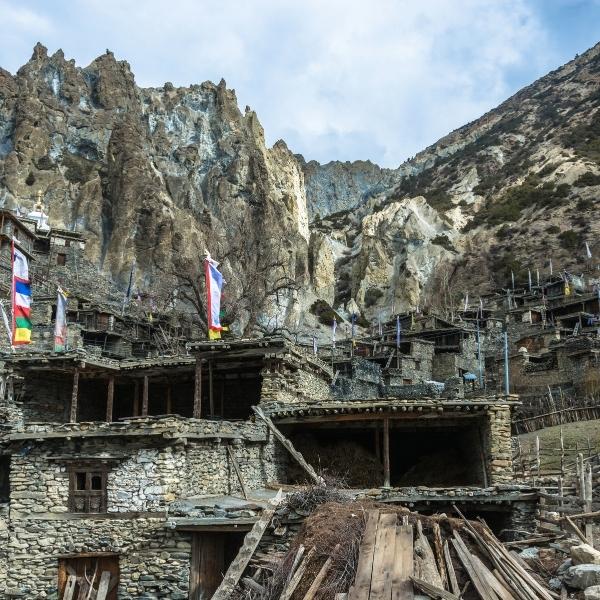
In fact, at Kyanjin Gompa (3,870m), you can visit one of the oldest Buddhist monasteries in the region i.e. Kyanjin Gumba. Besides that, there is also a Yak Cheese Factory in Kyanjin Gompa. This factory has been making cheese since 1955.
And guess what!! Every year 40% of trekkers visit this factory to taste or buy the cheese.
Furthermore, if you’re lucky with timing, you can also witness cultural festivals like Lhosar (Tibetan New Year in February/March) or Janai Purnima in August.
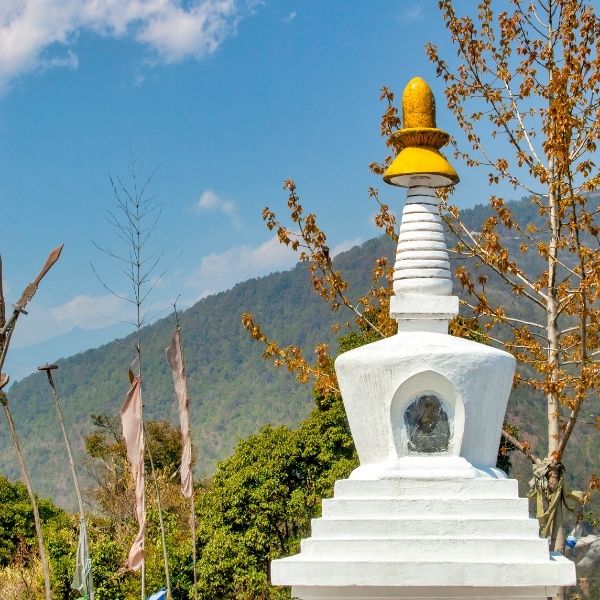
Though only 15% of trekkers plan their trip around these festivals, those who do often rate it as a highlight of their trek.
Furthermore, during the peak season, local lodges are known to organize traditional Tamang music and dance in their respective lodges. Attending this will give you insight into the art that has existed for more than 4 centuries.
And yes, before you bid your good-bye to the trek, don’t forget to check out locally made wool products and herbal teas. They are absolutely the best and about 25–30% of trekkers buy these things to take home.
Flora and Fauna In Langtang Valley Trek
If you aren’t a fan of cultural experiences, then hey, this trek comes with the gift of nature. This trek goes through the valley of the only Himalayan National Park of Nepal.
About 40% of the lower trails are covered in rhododendron forests, which bloom between March and May. These flowers paint the hillsides in red and pink. As you climb higher, you’ll pass through oak, pine, and bamboo forests.
Then you will finally reach open herbal fields where many rare herbs are grown and protected.
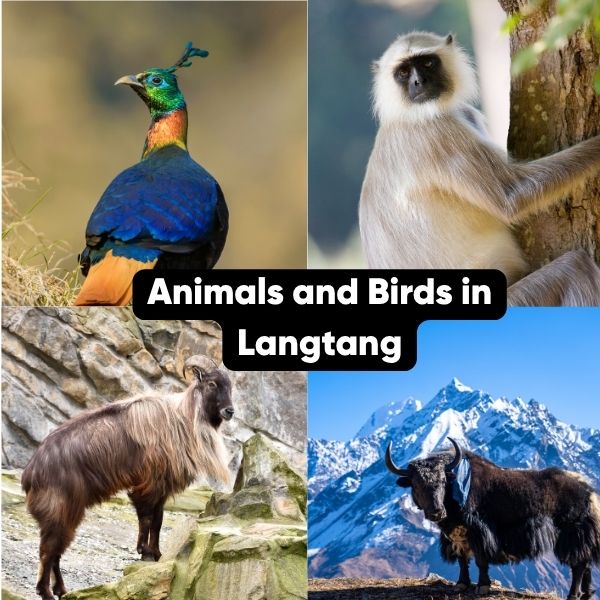
Talking about wildlife, this trek has many. But if you’re lucky, you might spot the elusive Red Panda (especially active in spring around 2,500–3,500m bamboo forests).
Other common sightings include Himalayan Tahr, Musk Deer, Langur Monkeys, and over 250 bird species including Nepal’s national bird, the Impeyan pheasant (Danphe).
Note: Snow leopards also inhabit the region but are rarely seen.
Tip: If you want to see the true beauty of Langtang, visit during Spring (March–May). As it is the best season for both rhododendron blooms and wildlife sightings, with red panda activity 40% higher compared to autumn.
Best Time To Visit Langtang Valley Trek
Now we hope you are convinced that this trek should be on your bucket list in 2025.
But you might be thinking, when should one visit this trek?
Well, the best seasons for Langtang Valley Trek are Spring (March–May) and Autumn (September–November).
Why? Because these are the seasons when the weather is stable.
Furthermore, in spring, you will walk beside all those reddish and pinkish rhododendrons. In addition to that, the weather will be so clear that you will get a movie-like view of all the snow-capped mountains.
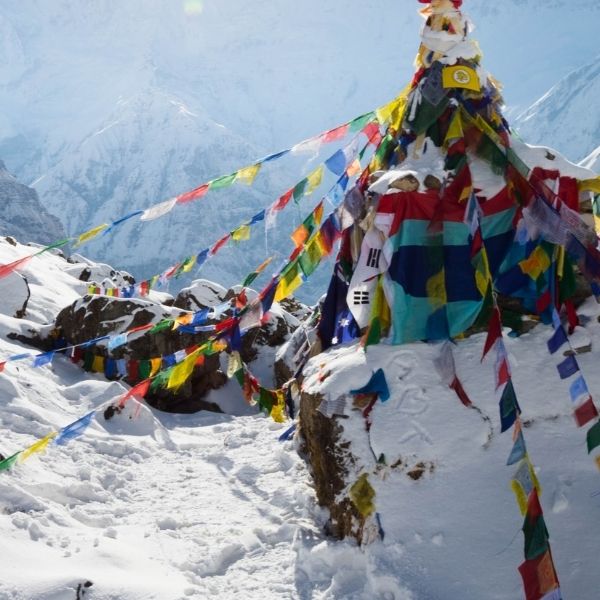
On the other hand, Autumn comes with clear skies and dry weather. In this season, trails are also a bit easier, which makes the trekking a bit easier.
However, monsoon (June–August) is wet and slippery. Trails are muddy, landslides are more common, and leeches… well, let’s not even go there. So, unless you are an adventure freak, we advise you to wait till the next season.
On the other hand, Winter (December–February) is the complete opposite – super cold, with snow above 3,000 m and night temperatures dropping to –10°C to –15°C.
So, which one should you choose?
- If you want blooming flowers and active wildlife – go in Spring.
- If you want the clearest views and safest trails – Autumn is your best friend.
These are also the times when most trekkers successfully complete the trek. In fact, trekking agencies report that spring and autumn have the highest success rates for reaching places like Kyanjin Ri.
Cost Breakdown & Budget Tips For Langtang Valley Trek
Now, let’s talk about money; because no trek planning is complete without knowing how much it’s gonna cost you.
Here’s where your money will go:
- Permits: TIMS Card – $18–25, Langtang National Park Entry – $22–25.
- Transport (Kathmandu to Syabrubesi and back): Public/tourist bus costs $10–20 one way, while a private jeep will set you back $180–200 one way.
- Accommodation & Food: Around $30–35 per day. For a 10-day trek, that’s about $300–350.
- Guides & Porters: About $25–30 per day, but most packages already include these costs.
You can expect to spend anywhere between $800 to $1,500 in total. The total cost always depends on your needs.
Solo Trekking In Langtang Valley Trek Isn’t Allowed Anymore
Now let us reveal a crucial thing. Solo trekking in Langtang Valley Trek is strictly prohibited.
Yes, it was possible back in 2024, but as of 15 February 2025, every trekker must hire a trekking guide or a nature guide.
Now you might be wondering why the government of Nepal came to such a conclusion.
Well, you already know the terrain includes dense forests and high-altitude zones. But what you might not know is it also includes landslide-prone zones and some very remote inaccessible zones.
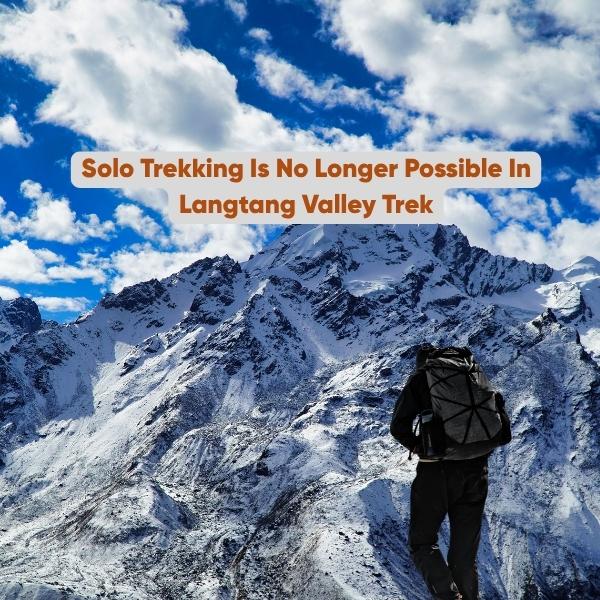
And there have been many instances where a solo trekker was found lost or injured in the remote valley. However, when a guide is by your side, the chances of trekkers getting lost are almost 0.
Which is why, to solve this problem, solo trekking has been banned for everyone.
Besides that, Langtang Valley is also a natural treasure of Nepal and when you are with a guide, they ensure compliance with park regulations and no ecological degradation.
Read More: Guide Mandatory for Langtang Valley Trek | New Rules 2025
Step By Step Guide To Hire Us For Langtang Valley Trek
We know the terrain!!! We know the trail!!! Our guides are friendly and experienced.
So, if you are planning to explore Langtang Valley Trek with safety and comfort, here’s how you can hire us:
Step 1: Visit Our Official Website
Go to econepaltrekkers.com and search for the Langtang Valley Trek page.
This page has everything you need to know – itineraries, cost, and what’s included in the package.
Step 2: Check the Package and Inclusions
Read the details carefully.
Here you will find:
- Duration of trek (usually 7 days standard itinerary)
- Cost based on group size and season
- What’s included: TIMS permit, Langtang National Park entry, licensed guide & porter, transport, accommodation, and meals.
- What’s excluded: Insurance, personal expenses, and optional activities.
Step 3: Choose Your Dates and Itinerary
Decide when you want to trek.
You can stick to the standard plan or request a custom itinerary (like adding Gosainkunda or extending your stay).
Our team can customize based on your experience and time.
Step 4: Fill Out the Booking or Inquiry Form
We offer two ways:
- Direct Booking Form (for fixed itinerary and date)
- Inquiry Form (for customization and special requests)
Just provide basic details like your name, nationality, date, group size, and preferences.
Step 5: Confirm Booking and Make Payment
Once you submit the form, we will contact you within 1–2 business days to finalize details and cost.
To secure your booking, pay the initial deposit (20–30%). The remaining amount can be paid upon arrival before the trek begins.
Step 6: Send Required Documents
We will ask for:
- Passport copy
- Passport-sized photos (for permits)
- Insurance details (mandatory for high-altitude trekking)
We handle all permit arrangements for you.
Step 7: Receive Confirmation and Preparation Guide
After your payment and documents are received, we send you:
- Booking confirmation voucher
- Packing list & trek preparation guide
- Arrival instructions for Kathmandu
Step 8: Arrive and Begin Your Adventure
We pick you up from Tribhuvan International Airport, introduce you to your guide and porter team, and make sure you are fully prepared before heading to Syabrubesi.
By the way if you are just looking to hire guide and porter, we provide that facility as well. You can check our article on Hiring a Guide and Porter in Nepal.
Why Choose EcoNepal Trekkers?
- Local Expertise: Our guides know every trail, every turn, and every safety tip.
- Licensed and Experienced: Fully government-certified guides.
- Eco-Friendly Practices: We strictly follow park and ecological guidelines.
- 24/7 Support: From booking to trekking, we’re always with you.
Ready to Go?
Visit econepaltrekkers.com, fill out the form, and let’s make your Langtang Valley Trek 2025 safe, exciting, and memorable.

